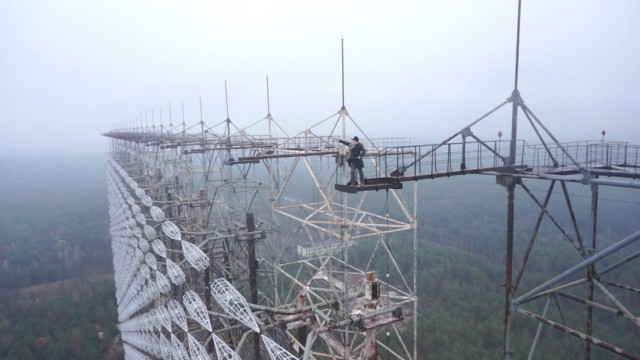Dear old people, please turn off your goddamned phones. If your phone rings once in a movie theater, it’s annoying. If it rings 5 separate times over the course of 90 minutes, you need to be banned from ever seeing a movie or a play in a public space ever again. It’s even worse when you’re in a relatively full house at a film festival.
This was the less-than-ideal situation under which I witnessed The Russian Woodpecker, a paranoiac documentary which defies logic and traditional construction but makes up for its flaws by possessing a bizarre immediacy. Chad Gracia, an American jack of all trades, somehow got connected with a nutball Russian performance artist, Fedor Alexandrovich, who wanted to do some sort of art piece on a Russian radar array right next to the Chernobyl disaster.
Alexandrovich was just a wee child who was evacuated when Chernobyl melted down, and will constantly carry the radiation of the meltdown in his bones. With the crisis permanently implanted in his body, he becomes fascinated with the whys of Chernobyl. Why did it melt down? His discovery of Duga-1, a gigantic radar array known as The Russian Woodpecker, in immediate proximity of the power plant leads him to connect the two creating a vast government conspiracy for the melt down.
The Russian Woodpecker, much like the old lady’s continuous phone ringing, was an over-the-horizon radar and signal disrupter. It used short and powerful staccato signals to interrupt radio signals and jam other transmissions in America and elsewhere. Started in the 1970s and continuing through 1989 (incidentally, three years after the Chernobyl meltdown), the Woodpecker was a bizarre annoyance that, according to Gracia and Alexandrovich, never lived up to its potential.
Gracia’s and Alexandrovich’s investigation is intentionally obtuse, alternately feeling like an art piece, a conspiracy doc, and a prophetic horror show. Started just as Putin was rising to power, The Russian Woodpecker began as a beautiful lark, but dives deep into Alexandrovich’s madness. As he continues diving deep, so does his paranoia. In between being distracted by the phone, the sum total of the evidence they have is the perceived deception and obfuscation they believe they see in Russian officials, and the intense feelings of paranoia they either have or create between them.
Oddly, they’re both on hand for the Euromaidan protests in 2014 as Ukraine and Russia start duking it out. There, one of their cinematographers is shot and injured by sniper fire, the camera destroyed, and the paranoia increases. Adding more to it is their note that The Russian Woodpecker started up again in 2013. Alexandrovich’s noted thesis for the film was that he felt the old Soviet Union was waking up again. If the movie doesn’t quite manage to prove that government leadership intentionally melted down Chernobyl to cover their asses, Gracia makes a great case for the warning of Russia under the leadership of Putin.
So, what to make of this movie, outside of that damned distracting phone which may have been a plant to fully experience The Russian Woodpecker for ourselves? When Gracia and Alexandrovich are making their art film, they manage to create some gorgeous imagery. When they make a paranoid documentary, the film comes up kind of short. But, when making a warning signal about the impending danger of the new regime the alarm bells are ringing. Does any of it make the film a success? Who the hell knows. I’ll be damned if I should even be allowed to review this movie because of that old lady’s phone. Ring.

